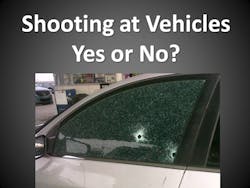It’s early morning in warm muggy Orlando and a call goes out of a report of shots fired. An officer spots the suspect vehicle with multiple occupants and attempts to stop it. When he does, the passenger in front takes off running and when the officer gives chase, the driver floors it and runs over the officer injuring him seriously. The officer was able to squeeze off a couple of rounds at the vehicle, but he remains in serious condition and is receiving specialized treatment in a Gainesville hospital.
Was the officer justified in shooting at the vehicle? Some departments are changing their deadly force policy so that officers may no longer shoot at vehicles. The verbiage in their policy states vehicles should not be automatically thought of as deadly weapons, therefore, officers should not use deadly force to protect themselves. Instead, cops are being told to move out of the vehicle’s path or move to cover. Really?
In a July 14, 2015 Force Science article, Dr. Bill Lewinski opines that, “. . . these policies seem to be driven by political pressure and are based more on speculation than on solid behavioral science.” I agree with the doctor’s assessment. Lewinski goes on to say that, “. . . prohibiting a police officer from shooting to disable a driver or persuade him to stop using a vehicle as a weapon is likely to increase the risk of injury and death to officers and possibly innocent civilians as well.”
Let’s consider the notion that vehicles should not be automatically thought of as deadly weapons. Many deadly force incidents occur in and around vehicles. As cops, we know that cars are deadly weapons. The public, however, doesn’t seem to comprehend that fact, and therefore, whenever a cop shoots at a car a public uproar results.
We know that a LEO may use deadly force necessary to protect self or others from the reasonably perceived threat of imminent death or serious injury. That threat can come in many forms—a gun, knife, a gang of thugs swarming you, or a vehicle coming directly at you. Nowhere is there an all-inclusive definition of what constitutes a deadly weapon, or an exact list of deadly weapons. Many objects can cause death or serious injury. They come in myriad forms. The officer in Orlando who was run over can attest to the fact that a vehicle is indeed a deadly weapon.
It seems clear to most rational thinking people that a gun pointed at them is a serious threat. Deadly force would be appropriate in this situation. An officer doesn’t have to think about the intent of the person pointing the gun at him, nor does he have to wait to see if the individual will actually fire the weapon. It’s sufficient that the officer reasonably believes the armed individual who is pointing a weapon at him poses a serious risk to inflict serious injury or death to the officer.
Similarly, the officer does not need to consider the driver’s intent as a car speeds toward him. If he feels his life, or someone else’s life (e.g., the officer’s partner) is in danger, the officer is justified in using deadly force. The approaching vehicle is a deadly weapon.
Media often misrepresent the issue of shooting at fleeing vehicles. Their logic seems to fall under the category of, “if the threat is leaving, deadly force is no longer justified.” They are wrong.
The Supreme Court in 1985, via the Gardner decision, said deadly force is justified to prevent the escape of a dangerous suspect. The Court clarified that a dangerous individual poses a clear threat to pursuing officers and to any citizens that may be encountered. Therefore, it is desirable to prevent potential harm to others , and in fact justifies the use of deadly force to prevent escape of dangerous individuals and thus a continuing threat if left at large.
It would seem that to change a policy to exclude shooting at vehicles puts officers at unnecessary risk. Moreover, we train officers to use deadly force when their lives or the lives of others are at risk. To retrain them not to shoot at a vehicle when it poses a threat is insanity. Vehicles are weapons, sometimes perhaps deadlier than firearms or cutting instruments. Why would you prevent an officer from defending himself or defeating such a powerful weapon as a vehicle? You wouldn’t.
Stay Safe, Brothers and Sisters.
Links:
About the Author
John Wills
John M. Wills is a former Chicago police officer and retired FBI agent. He is a freelance writer and award-winning author in a variety of genres, including novels, short stories and poetry. John also writes book reviews for the New York Journal of Books, and is a member of the National Book Critics Circle. His new book, The Year Without Christmas, is available now. Visit John at: www.johnmwills.com.

